Sponsored Post: Call Reliant Real Estate today

Click here to view this listing.

Click here to view this listing.
Genesee County Legislature Chair Rochelle Stein expressed “shock and surprise” today over the circumstances surrounding the profound changes made to the structure and voting parameters of the Western Regional Off-Track Betting Corp.’s board of directors.
On Tuesday night, it was announced that language in the just-adopted state budget includes a bill to dismantle the current 17-member board and revoke the one-person, one-vote arrangement that has been in effect for 50 years.
“I was not of the understanding, quite frankly, that this was going to be part of the budget,” Stein said by telephone. “That to me was a shock and a surprise. It is surprising the policy is so wrapped up in a financial document.”
Stein segmented her thoughts into specific areas affected by the legislation, namely the removal of the 17 current directors, the appointment process, the weighted voting format, the county legislature having to appoint or reappoint the director and the host agreement status of Genesee County, the Town of Batavia and the City of Batavia.
DISMISSAL OF CURRENT BOARD?
“What is even more surprising is that it calls for the immediate removal of the 17 current directors, and the counties will be faced with reappointing or appointing a new director,” she said. “Directors, for counties without executives, would be chosen by boards of supervisors or county legislators.”
Richard Siebert has been Genesee County’s director on the WROTB board for nearly 30 years.
Although the process of selecting a director for Genesee County wouldn’t change, it would have to start from scratch as a result of the new provision.
“When we get the bill back, the bill itself, we will work with our county attorney to ensure that when actions must be taken, we will have to comply with the law,” she noted. “That’s number two.”
The third point she addressed is what she called “the incredible change to a weighted voting (system).”
“If my math is correct, 62 percent of the vote will be held by Monroe and Erie counties and the cities of Rochester and Buffalo,” she said. “What means to me is that an organization that is returning funds back to its owner municipalities – and is proven to be highly successful – … will see a reduction in the influence and the leadership and guidance that has proven valuable for this organization to grow …”
Stein said that the county has reaped exponential returns from the initial $23,000 investment it made in 1974 to buy into the public benefit corporation.
“I know that this county has been well benefited by those returns,” she said. “And we in Genesee County are more impacted because we currently have host agreements with the Downs as we provide to the entity fire, public safety, highway services. Since OTB is a non-taxpaying entity for property taxes. So, these three communities -- the county, town and city -- receive a host benefit.”
A POLITICAL POWER GRAB?
Stein, echoing several Republican state representatives, called the bill “a power grab.”
“It’s so political, and it has been so toxic because of certain individuals,” she said. “The rest of us still have to maintain a decorum where we can get business done at the Downs and at OTB because record profits have been shared out to counties.”
She noted that revenue is shared through a “home rule” statute that was passed many years ago by the state legislature and approved by the governor.
“All that could change, but I hope it doesn’t,” she added.
The legislature chair also said she was disappointed that the county’s representatives in Albany were unable to read the bill beforehand.
“George Borrello and Steve Hawley were not able to read that bill until after it was passed. So again, the three people in a room (actually two men and Gov. Kathy Hochul) have not served us well at all here in New York State,” she said.
Stein also spoke about the state Comptroller’s audit that found deficiencies in certain areas that triggered State Sen. Tim Kennedy’s push for board restructuring.
“OTB is just like any other public entity,” she said. “They’re audited. There are deficiencies found. The organization has an opportunity to address the deficiencies and to improve or change aberrations.
“That's exactly the same behavior pattern that we have in our local governments that the OTB just underwent, and they certainly have taken those deficiencies, and they've corrected them. They took those words and made themselves stronger, better and more resilient.”
SEN. KENNEDY’S STATEMENT
The Batavian sought comment from Kennedy today, but his media manager said he was unavailable today.
She did email a statement from him, however:
“We talk a lot in the state legislature about prioritizing accountability and transparency - about rooting out corruption. Last night, we created an opportunity to deliver on that. From audits to investigations, the Western Regional OTB has been plagued with a pattern of mismanagement and misconduct for years, and a slap on the wrist isn't going to fix this behavior long-term.
“By including a reform I've sponsored to restructure the OTB's board in this year's budget, we're introducing an opportunity for fair representation that serves the public good. This is a common-sense, good government policy, and it's a reflection of the real, meaningful work we continue to advance on behalf of Western New Yorkers.”
Stein took exception to the use of the word “corruption.”
“That's a really strong word. The value that we have in our rural county representatives is that actually most of them know how to run a business. So, they have been sharing their expertise and guidance for years, which has proven beneficial to the off-track betting, to Batavia Downs, to the plans to grow the opportunities here in Genesee County.”
RETALIATION IN PLAY?
She also said the bill reinforces the perception that “only New York City matters to the powers-that-be in Albany.”
“For the state only to look at Western New York when there are four others (OTBs) really makes this smack of retaliation, it makes it smack of It makes it smacks of a power play. For an organization that is returning funds back to its member counties, it is throwing away years of guidance and leadership and business development at OTB and the Downs.”
Stein concluded by recalling something that Siebert said to her about the merging of Batavia Downs and WROTB.
“One thing that Mr. Siebert told me a long time ago was when the racetrack was approached by OTB to join together, they were very concerned about where their representation might go,” she said. “Well, today's the day it happened. And I can't respect the process that this went through. In my view, it is completely unfair and totally unnecessary.”

Nothing like the smell of burnt shopping cart to go with your morning coffee.
That was just one of several teasers thrown online to pique viewers’ interest during these past four months of preparation for a surprise exhibit on the city’s east side.
Considering the involvement of artists, sponsoring businesses, with the lead being GO ART!, and Harvester Center LLC serving as host, this project has been kept under wraps fairly well.
That is until now, when founders Brian Kemp and Mary Jo Whitman decided it’s time to announce: Enter Through The Coffee Shop @ The Harve.
“So Brian came to me with this idea, he was like, ‘We should take over an industrial space and see what we can do.’ And you know, Brian always has a lot of ideas. And the next day, he said, can you meet me at the Harvester in 30 minutes? He showed me the room, and he's like, ‘You want to do it?’ I'm like, ‘All right. ‘And that's how it started,” Whitman said.
While that may sound like a rather calm beginning, it has been anything but ever since they temporarily claimed the 7,000-square-foot space at 56 Harvester Center in January.
Rectangular in shape, with long rows of windows for ample natural sunlight, it’s a space easily accessible through The Pub Coffee Hub, owned by Rob Credi.

Kemp and Whitman put the word out for artists, and the walls have been gradually bleeding color with brilliant murals and 3D sculptures, while the room's footprint has been carpeted with the shell of a red car, artwork and the makings of a bar area.
Is it an art exhibit? A gallery? A space for mingling and reflection while enjoying refreshments and listening to live music? Or perhaps a new avenue for artists to publicly expose their creations? Yes, yes, yes and most certainly, yes.
One other possibility, of course, is that it also brings people over to Harvester Center, which seems to be getting more buzz as a growing business center again.
The Harve’s debut will be with an opening reception from 5 to 11 p.m. June 3, and a VIP invitation-only event the evening before.

Step into the capacious room, and it’s hard not to notice the sweeping mural of a blonde-haired, vivid blue-eyed doll on one end wall that sits next to a take on the Cheshire cat in a vibrant purple atop red mushrooms in a dazzling, eye-catching still vignette. And all of it was painted by Dan Butler in an astounding four days.
Across the room in a corner is Kemp’s studio, filled with various materials and about 20 works already done.
“It’s been cool having this much space,” he said. “I have 10 more things I’m working on.”
On one wall is Whitman’s sculpture-in-progress. It seems fitting, given a prior disclosure, that she often leans toward darker works of art.
A big black puff of clouds stretched along toward the top of the wall, with two people dressed in black below, and one of them with a shopping cart — painted black — against the wall. It actually rains, and the clouds have lightning, she said.
From those early moments of walking into such an expansive space, she and Kemp didn't really fumble with ideas of what to do or how to go about bringing their collective visions to life, they said.
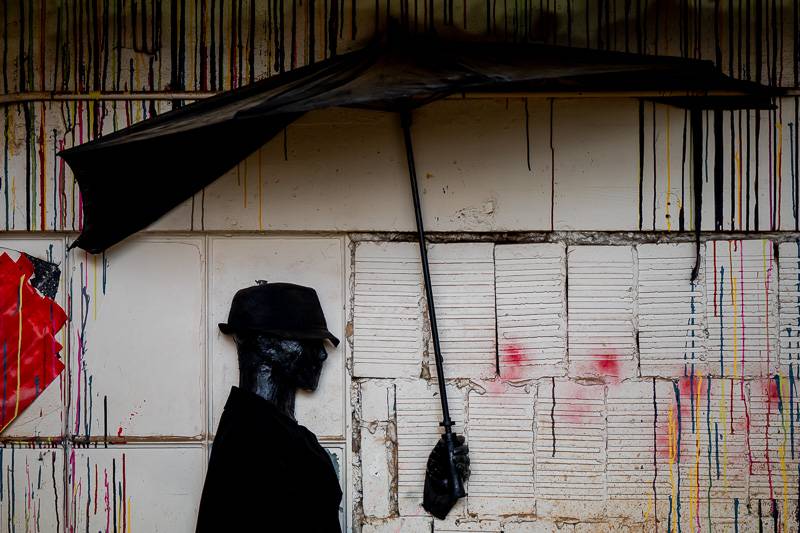
“It’s absolutely amazing how everything has just fallen into place. Rob’s extending his hours when we’re open Fridays and Saturdays in June,” Whitman said. “We just started asking questions. There was a BBC documentary, ‘Exit Through the Gift Shop,’ so it’s a parody of that, ‘Enter Through The Coffee Shop.'
“It was just perfect clarity based on ‘Exit Through The Gift Shop,’ but kind of an opposite message that you know, instead of commodifying the arts let’s bring the arts to people to help support local business,” she said.
There will be two cars in the show, and they will hopefully be in the demolition derby in July, Kemp said. Having wheels helps with their other vision for the main floor, which brings together street art, graffiti and murals.

“We’re literally going to have the place kind of like a street, we're gonna have little elements of this street scene. Like we're trying to make it look like a street … traffic cones, construction cones, the cars,” he said. “You can just come in and walk around. You can grab a seat. Rob … will be open, so you can grab a coffee or a sandwich. We're hoping to have some alcohol available.”
There are a couple of comfy couches there right now for seating, and tables and chairs will be moved from The Pub Coffee Hub for exhibit patrons, he said. They have booked four acts for live music already, with the potential for more.
They’ve worked with about 10 artists, Credi and Jarrod Clark, who manages Harvester Center LLC. Go HERE to stay up-to-date on details.
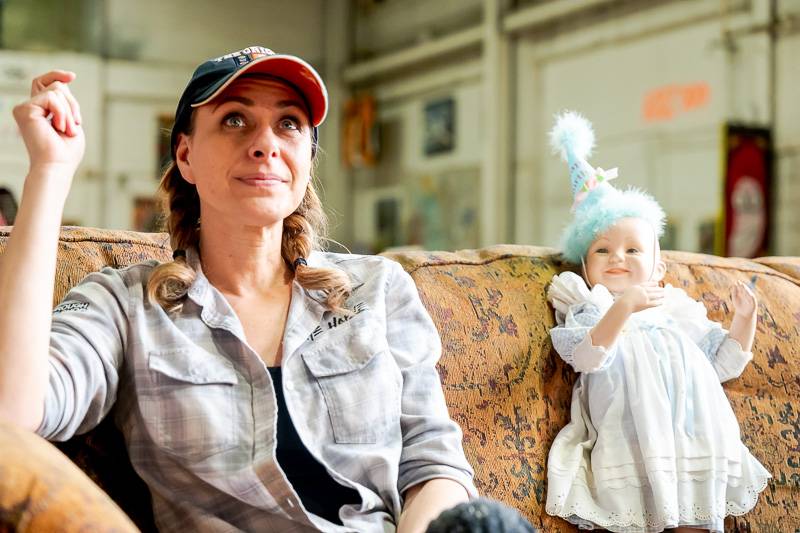
Photos of Brian Kemp, an artist and owner of T-Shirts Etc. in Batavia, and Mary Jo Whitman, an artist who works at GO ART! in Batavia, at The Harve at 56 Harvester Ave., Batavia, by Howard Owens.

Since United Memorial Medical Center has partnered with Healogics, an industry leader in wound care, it has cared for 9,000 patients and 40,000 wounds in the last seven years alone, with "highly skilled and trained staff” leading the hospital’s Wound Care and Hyperbaric Center as the recipient of two awards for its treatment achievements this week, Healogics Director of Operations Toni McCutcheon said Tuesday at the North Street facility.
“There are 65 collective years of experience in this wound care center, which is amazing. They provide exceptional wound care within the community. And since the center's opening, they have encountered nearly 40,000 wounds. It's amazing. It's amazing what the center does, it is reasonable to expect this center to have exceptional care and amazing healing outcomes,” she said. “So with that, the first award I'm going to present is an award for Clinical Excellence. This award is achieved by clinics that are in the top 10 percent of the wound meats adjusted comprehensive heal rate. The center is compared against over 600 other centers within the country that achieved top 10 percent.”
She added that, having visited the center, it’s an obvious team effort, and “these patients are well cared for and their wounds are healed and that's important to get them back their quality of life.”
This is a first for the Clinical Excellence Award, and a seventh time to be named Center of Distinction.
Dan Ireland, CEO of UMMC, spoke on behalf of hospital leadership and the board to congratulate the team and tell them, “we can’t be more proud of what this team has accomplished for the seventh time.”
“I can reflect on years ago when we first opened the center, we were all excited to have hyperbaric machines like that was the really cool thing to have. And we would show them off, but it quickly went beyond the fact of the equipment that we have, but to this great culture of a care team that we have here,” he said. “And it can't go without noticing it is all types of providers that play a role in here. You know from from Dr. Canzoneri and his provider team, to our PAs to our LPNs to our nurses to our support staff. They collectively work together to make sure that care is provided to the highest level and to be able to receive an award like this with such high score.”
One his Dr. Joseph Canzoneri’s “special patients,” Cherry Carl, shared her story of needing help for a hematoma that was ‘huge, painful” and could not be treated by her primary care physician. So she researched it and found UMMC’s Wound Care Center.
She drove two hours round-trip, and Dr. Canzoneri agreed to help. He explained what he was doing step-by-step and treated cut out the hematoma so that she could heal.
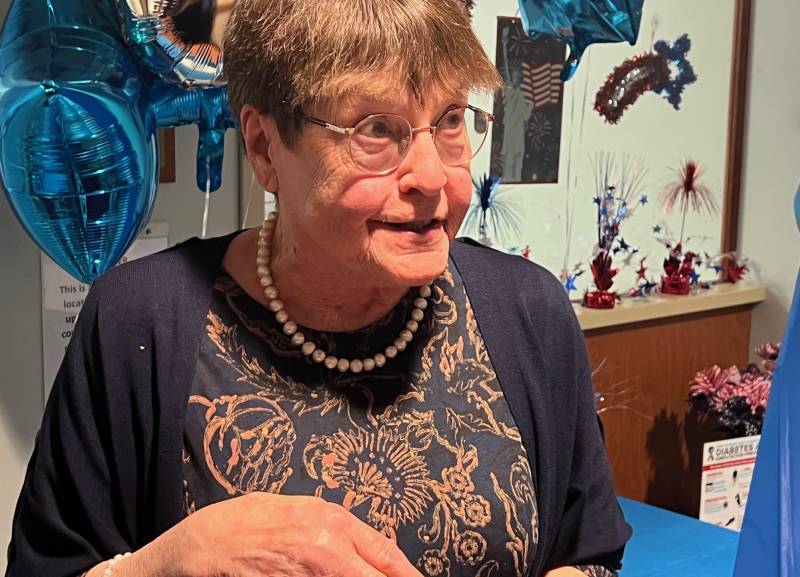
"No matter who you are, no matter where you are in your life's journey, you're welcome here. And no wound I think, is too small in this place. And then he exudes confidence. And he made sure that I knew what I had to do when I went home,” she said. “That meant weeks of coming here once a week, so he could scrape and scrape, and then it healed, but I if I hadn't come … because the wound was infected with Mersa an E. Coli. And if I had ignored it, I don't know.”
Canzoneri said that 50 million people globally suffer from foot and leg ulcerations each year, and the average healing time in most cases is over a year. That puts patients at high risk for amputations, death and other comorbidities, he said.
“Studies have proven and shown that basically, this team approach that we have here, especially at UMMC, helps reduce these comorbidities and mortality by 9 percent. Now, our job at UMMC wound care is not just to heal the patient, but it's to heal the patient as fast as we can and prevent the reoccurrence,” he said. “Our team approaches and uniqueness at UMMC help us further utilize our well-trained nurses, our dieticians, hospitals, physicians, infectious disease team vascular specialists, podiatry, orthopedics, nephrology, endocrinology or cardiology consultants, radiology, physical therapy, orthotics, home nursing care, and I'm sure a few others I forgot to mention.
"This ability to coordinate quickly and effectively is what the patient needs in our Wound Care Center is what really makes us and helps us achieve that seven-year center of distinction,” he said.
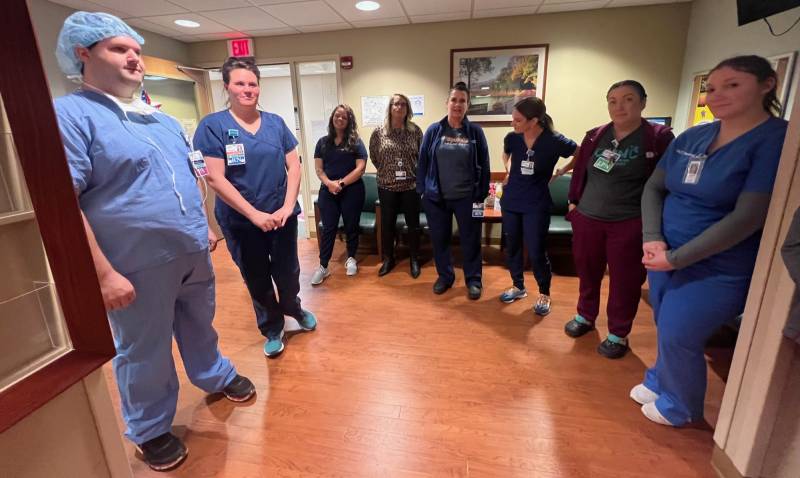

Top Photo: Toni McCutcheon, director of operations for Healogics, left, presents an Award of Clinical Excellence to United Memorial Medical Center's Wound Care and Hyperbaric Center, led by Dr. Joseph Canzoneri, far right, Tuesday at the Batavia facility; team members celebrate their seventh Center of Distinction Award, also presented during the event; and a special patient shares her story with event participants. Bottom photo, a poem written by Cherry Carl for Dr. Joseph Canzoneri. Photos by Howard Owens.

Press Release:
Due to weather, the paving project in the Save-A-Lot parking lot has been postponed to the following schedule:
Friday, May 5
- Overnight parking (tenant) area closed for paving operations
Monday, May 8
- Overnight parking (tenant) area closed for striping of lot
Tuesday, May 9
- Paving west side of entire lot
Wednesday, May 10
- Paving east side of entire lot
Vehicles that are using permitted parking are asked to temporarily use the City lot off of School Street or any other permitted parking areas in City owned lots.
Thank you for your cooperation.
Photo of parking lot next to Save-a-Lot in downtown Batavia by Howard Owens.
Jason W. Whitehead, 25, of Bank Street, Batavia, is charged with criminal possession of a controlled substance 7th, possession of a narcotic with the intent to sell, harassment 2nd, resisting arrest and use of drug paraphernalia 2nd. Batavia patrol officers located Whitehead, who had an active warrant for his arrest, walking on Bank Street on April 16. Whitehead allegedly fled on foot when officers attempted to arrest him. A private citizen assisted Officer John Gombos and Sgt. Christopher Lindsay in stopping Whitehead. The officer took Whitehead into custody. Whitehead was allegedly found to be in possession of a quantity of drugs and drug paraphernalia. Whitehead was arraigned in City Court and remanded to the Genesee County Jail on no bail.
Cassandra F. Smith, 37, of Manhattan Ave., Batavia, is charged with two counts of petit larceny. Smith is accused of stealing various items from a yard on Manhattan Avenue on April 8. Smith was released on an appearance ticket. On April 12, she was charged with criminal trespass 2nd. She is accused of entering and remaining unlawfully in an apartment on Washington Avenue, where she left a note for a resident to find when the person came home. She was arraigned in Centralized Arraignment Court and released. She was charged with criminal mischief 4th on April 12. She is accused of spray-painting an apartment door, doorbell camera, and van in the driveway of a residence on Washington Avenue. She was arraigned in Centralized Arraignment Court, and her release status is unknown.
Joseph C. Jeffords, 32, of Chestnut Street, Batavia, was arrested on two bench warrants issued by City Court. Jeffords is accused of failure to appear on two prior appearance tickets, one for alleged unauthorized use of a motor vehicle on Jan. 23, and the second for alleged criminal possession of a controlled substance 7th on Feb. 6. He was arraigned in Centralized Arraignment Court, and his release status is unknown. Jeffords was also arrested on April 9 and charged with two counts of criminal possession of a controlled substance 3rd. Jeffords was allegedly in possession of various narcotic drugs upon being arrested on multiple warrants. Jeffords was arraigned in City Court and custody remanded to the Genesee County Jail in lieu of bail.
Salvatore Dellapenna, 54, of Vine Street, Batavia, is charged with criminal mischief. Dellapenna is accused of damaging a neighbor's front door by kicking it in on April 8. He was issued an appearance ticket.
Patricia M. Anderson, 38, of Buell Street, Batavia, is charged with petit larceny, operating a motor vehicle while the registration is suspended, and aggravated unlicensed operation of a motor vehicle third. Anderson is accused of filling a shopping cart with $139 in merchandise and leaving the business on East Main Street, Batavia, without paying. During the investigation, it was allegedly found that Anderson operated a motor vehicle with a suspended registration while her license was suspended. Anderson was released with an appearance ticket.
Modesto O. Cardenas, 29, of Pearl Street, Batavia, is charged with harassment in the second degree. Cardenas was arrested by Officer John Gombos following an investigation into a disturbance on April 1. He was arraigned in Centralized Arraignment Court, and his release status is unknown.
Linda L. Snyder, 40, of Creek Road, Batavia, was arrested for bench warrants issued by City Court and charged with bail jumping in the third degree. On April 5, Officer Peter Post arrested Snyder on bench warrants issued by City Court for harassment, criminal mischief, and animal cruelty charges. Additionally, Snyder was charged with bail jumping 3rd because she failed to appear in court as directed after being released on her own recognizance from a criminal proceeding. Snyder was arraigned in City Court and custody remanded to the Genesee County Jail in lieu of $1,000 cash bail.
Josia G. Culver, 18, of Tracy Avenue, Batavia, is charged with two counts of burglary 3rd, two counts of criminal mischief 4th and petit larceny. Culver is accused of breaking into a local restaurant on Ellicott Street on April 14. He is accused of breaking into another restaurant in the mall on April 16 and stealing money from the register. His release status is unknown.
Lori A. Wittkopp, 61, of Spencer Court, Batavia, is charged with DWI and driving with a BAC of .18% or greater. On April 14, Officer John Gombos stopped Wittkopp following a complaint that Wittkopp was driving while intoxicated. Wittkopp was issued appearance tickets.
Kendra Q. Thomas, 35, of Dellinger Avenue, Batavia, is charged with harassment 2nd and endangering the welfare of a child. Thomas is accused of a physical altercation with a juvenile on April 15. Thomas was issued an appearance ticket.
Luis J. Santiago Arroyo, 34, of Buell Street, Batavia, is charged with harassment 2nd, endangering the welfare of a child, and criminal contempt 1st. Arroyo is accused of being involved in a physical incident during a custody exchange on April 23. Arroyo is accused of striking another person, unprovoked, who was covered by an order of protection while she was holding a child. Police say a Ring camera captured video of the incident. Arroyo was held in the Genesee County Jail pending arraignment. Release status unknown.
Aaron T. Hendershot, 26, of Ellsworth Avenue, Batavia, is charged with criminal contempt 2nd and aggravated family offense. Hendershot allegedly violated an order of protection on April 20 by calling, messaging, and writing letters to the protected party. He was additionally charged with aggravated family offense as he has been convicted of a specified offense within the immediately preceding 5 years, Feb. 6, 2023. Hendershot was arraigned in City Court and custody remanded to the Genesee County Jail without bail.
Alisha A. Soule, 26, of Route 237, Le Roy, is charged with harassment 2nd and criminal mischief 4th. Police responded to a reported disturbance on April 26. Soule is accused of kicking in a door to gain entry to a house and then striking one person while attempting to get to another person. Soule was arraigned in City Court and released.
Pamela L. Dickinson, 60, of Roosevelt Avenue, Batavia, is charged with DWI, failure to comply, speeding, and failure to yield to an emergency vehicle. At about 6:30 a.m. on April 24, Officer Joseph Weglarski reported observing a vehicle speeding on Pearl Street. The driver allegedly failed to stop until being blocked by patrols at the intersection of Washington Avenue and Bank Street in Batavia. Dickinson was released on traffic tickets.
Shelby L. Fryer, 27, of Prune Street, Batavia, is charged with criminal impersonation. Officer John Gombos stopped a vehicle reportedly driven by Fryer on April 22. She allegedly gave a false name to the officer in an attempt to avoid an arrest on a warrant. She was arrest on a warrant for alleged failure to appear. She was arraigned. Her release status is unknown.
Haley M. Larnder, 23, of North Street, Batavia, was arrested on a City Court arrest warrant. Officer Andrew Mruczek located Larnder on April 21 and took her into custody on a warrant. Larnder was originally arrested on March 19 on a charge of criminal possession of a controlled substance 7th and issued an appearance ticket. Larnder was arraigned in City Court and released on her own recognizance.
Jacqulyn A. Dueppengieser, 39, on Page Road, Perry, is charged with petit larceny. Dueppengieser is accused of stealing from a business on East Main Street on April 20. She was issued an appearance ticket.
Natasha J. Durney, 29, of Hutchins Place, Batavia, is charged with nine counts of harboring an unlicensed dog. On April 21, Officer Stephen Quider responded to a report on Hutchins Street of dogs fighting on Hutchins Place. During the fight, a person was reportedly bitten. Durney is accused of owning nine unlicensed dogs. Durney was issued an appearance ticket.
Jessica Hernandez, 35, of Summit Street, Batavia, was arrested as a fugitive from justice. Police officers executed an arrest warrant on April 22 after being contacted by the Volusia County Sheriff's Office in Florida. The police department was informed that Volusia County had a warrant for Hernandez on the charge of aggravated assault with a deadly weapon. Hernandez was processed, arraigned in Centralized Arraignment Part Court and held at the Genesee County Jail to await extradition to Volusia County, Florida.
David A. Kendall, 50, of Bank Street, Batavia, is charged with criminal contempt 2nd. Kendall is accused of violating a stay-away order of protection on April 23. He was issued an appearance ticket.
Adam M. Zastrocky, 38, of Myrtle Street, Le Roy, is charged with DWI, driving with a BAC of .18 or greater, failure to stop at stop sign, driving left of pavement markings in no passing zone, and refusal to take breath test. Zastrocky was arrested by Sgt. Jason Saile following an investigation into a motor vehicle accident reported at 10 p.m. on April 20 on Cockram Road, Byron.
Joseph Earnest Marr, 44, of Nesbitt Road, Batavia, is charged with grand larceny 4th. Marr is accused of stealing a phone while at Batavia Downs. He was processed at the Genesee County Jail and released.
Nathan Paul Crawford, 27, of Federal Drive, Batavia, is charged with two counts of petit larceny. Crawford is accused of shoplifting from 48 Deli Express at 5:04 p.m. on April 15. He was issued an appearance ticket. He is also accused of shoplifting from Kohls at 11:05 a.m. on April 19. He was issued an appearance ticket.
Heather Nicole Derooy, 33, of Keith Terrace, Chili, is charged with criminal possession of a controlled substance 7th, aggravated unlicensed operation 3rd, and improper plates. Derooy was stopped at 8:26 p.m. on April 8 on Clinton Street Road, Bergen, by Deputy Nicholas Chamoun and Deputy Kenneth Quackenbush. She was allegedly found in possession of methamphetamine. Derooy was released on an appearance ticket.
Robert E. Sacher, 53, of Kibbe Avenue, Batavia, is charged with DWI. Sacher was stopped at 3:11 p.m. on April 13 on Veterans Memorial Drive by Deputy Jonathan Dimming. Sacher was issued traffic tickets and released.
Jeenathan Rodeny Williams, 63, of Hazelwood Terrace, Rochester, is charged with criminal possession of a controlled substance 7th, aggravated unlicensed operation 3rd, unlicensed driver, side wings/side windows non-transparent, and plates covered by glass or plastic. Williams was stopped at 6:56 p.m. on April 25 on Byron Elba Road, Byron, by Deputy Zachary Hoy and issued an appearance ticket.
Scott Aaron Muntz, 25, of Maltby Road, Oakfield, is charged with DWI, driving with a BAC of .08 or greater, and speeding. Muntz was stopped at 12:15 a.m. on April 16 on Knowlesville Road, Alabama, by Deputy Jonathan Dimming. He was issued traffic tickets.
Madison McKenzie, 18, of Creek Road, Batavia, is charged with endangering the welfare of a child. McKenzie is accused of giving a letter to a child under age 17 that contained sexual content. McKenzie was arraigned and released.
Michelle Dawn Grover, 38, of Olean Road, South Wales, is charged with petit larceny. Grover is accused of shoplifting from Dollar General in Pavilion at 10 a.m. on March 5. Grover was issued an appearance ticket.

Erik Fix was president of the Genesee County Chamber for 15 months before he filled the role of assistant city manager in July 2022. He joked that his kids ask him all the time, “When will you get your next job?” even though he's enjoying his current gig and has no plans to leave any time soon, he said.
He says that he likes a challenge, and now, at just two months shy of his one-year anniversary with the City of Batavia, Fix sat down with The Batavian to review his latest responsibilities and perspectives as a city official.
Do you feel settled in at this point, or are you still learning the ropes?
“I don't know that I'll ever feel settled in. And I'm sure I will always learn, there's just so much to do and learn in this position. But I do feel like I can start to add value in places. Whereas the first, four or five months, it was just, running around, trying to learn everything and get a grasp on things,” Fix said. “And now I feel like I have a good base now … where I can use my skill set to actually add value. There's obviously still areas that I have no idea about, or a small amount of knowledge of, but I do feel like when somebody mentions something, I know what they're talking about now. So that's good.”
Was it easier or more difficult to go from the county scope of a chamber to your particular tasks for the city?
"That hasn't really been the biggest challenge. It's actually, from that standpoint, it's a little bit easier to be able to focus on tasks and get them accomplished. I was only at the Chamber for a short period of time, but when you're there, you're looking at the overall viewpoint of the entire county and all the expenses. So if you're talking about doing something, you’ve got to think about how is this going to affect each individual village and town, as well as the city,” he said. “And here you can narrow the focus a little bit more, focus on, you know, our little neck of the woods. Obviously, we have to continue to collaborate with the county and with different entities, but you're able to kind of streamline that, the difference is the workload.
"And the capacity that we deal with here at the city is much greater than what we're dealing with as a chamber … supporting all the businesses in the community to having a full-time fire department and full-time police department, DPW, the whole nine yards," he said. "Just the grand scale of what it is to run a city is much larger than what we're dealing with the mission of the chamber.”
Why did you want this job?
“The challenge. I saw it as an opportunity to just really get my hands dirty and become a part of something and see my work pay off in a lot of different ways. If you were to ask me two years ago, if I found myself in a municipality working, I'm like, no, what are you talking about? It's crazy. But I really feel like it's been a blessing, and it's actually turned out better than I thought, even after I thought it was gonna be a really good opportunity,” he said. “It meshes well with my skill set, it meshes well with the fact that it's constantly active and keeps me busy and keeps my mind working … it’s just been really good. I'm really pleased with the move.”
During City Council budget talks, it seemed to be a running joke to “blame Erik” for increased communications costs due to a new phone system. That’s because it was one of the items on his to-do list as assistant manager.
The current phone service had become outdated, and the city had no one able to service the phone system anymore, he said. If something had happened to a phone or to the system in general, “we were kind of out of luck,” he said.
“So it's very important that we went through that process and got a new phone system, which also came with new phones, and we got that project moving. So when I got here, we were just in the process of going out to RFP, and getting proposals in for that,” he said.
He talked in detail about what that actually meant to get it up and running. There was the actual installation and building the system from scratch — if you call and get a voicemail, where will that go? Who will answer? Who needs this type of extension versus another type of extension?
All totaled, it was “150 some odd numbers we had to deal with,” he said. And there’s the reason for “blame Erik.”
“So it was a very expensive process that we went through. And then the other one is just going to be starting up next week, which, again, was maybe 25 to 30 percent started when I got here, but that's our online billing system for water bills. So that is how to work with our existing systems that we have, as well as the bank system," he said. "And this month’s bill in May will be the first time that folks will have the ability to go online to pay their water bills, which will be a huge benefit to not only our residents, but it's a huge benefit to our clerk's department, because hopefully, it helps alleviate a lot of what they're doing on a day-to-day basis, and making it easier for folks to take care of that.”
He brought in “a little bit of analysis” experience in regards to an online bill pay system from having worked at M&T Bank, Fix said.
“But it was mostly just project managing and ensuring that deadlines are being met and things were happening along the way that needed to get done. We were just wrapping up our software system launch, which there's still some bits and pieces of that that we'll be doing probably for the next year, year and a half until that's totally 100 percent on board," he said. "So learning that whole system, things like that took a lot of my time. I will tell you, I am not an IT person. I'm not an IT expert. But again, just utilizing the ability to project manage and things like that. It's been nice.
"And obviously we have folks here, Rachael included ... she was assistant manager, she was a great resource to help me get through that stuff. So that's a large portion of what we're doing," he said.
The list goes on, from a housing initiative to shore up an old housing stock in the city to reinvigorate neighborhoods. Fix, 51, wanted to get his hands dirty, and he'll have plenty to dig into.
"We've got new projects coming up, we've got new projects we want to see happen in the future. We want to start developing programs for people that want to renovate. And that's what the home fund is going to help us do is provide funding for those types of things," he said. "So it's a very large, encompassing project that we're trying to figure out right now. We have a housing group that meets on a monthly basis, and we're starting to prioritize where we start first, and what's the first step to really get this off the ground. And so that's going to be a significant part of the next probably three to five years to really get to where we want it."
Another of his responsibilities is to lead the City Centre entryway project, which was sent back to the drawing board for new estimates after previous ones came in above budget. There are four entryways, and a primary goal is to remove the silos, which leak, and then replace them with something that is “aesthetically pleasing and effective,” Fix said.
He believes that the project is back on track and is hoping for estimates to come back closer to what city officials had wanted.
Erik, what do you think about this job? How are you feeling as far as your longevity here?
"I'm not going to say it’s my last up because I said that at the Chamber. But I enjoy this position a lot. We've got a great staff. I've got a great group of people around me that are supportive and helping me to learn,” he said. “I feel like there's something to learn every day. And it's just a constant challenge."
Fix lives in Le Roy with his wife, Susan, and they have three sons, Brady, Jackson and Carter. Le Roy is a great community, and the school district is fantastic, Erik said, but Batavia has been and is his hometown.
As for the city, he wants to see it continue to grow into "a walkable, approachable, thriving downtown area."
"We've got a lot of momentum," he said.

Press Release:
With a roster of 55 players and about a dozen sponsors in hand, the Genesee County Spartans organization is moving full speed ahead toward competing in the Northeastern Football Alliance this summer.
“We’re into the third week of training camp, preparing for an intrasquad scrimmage at 1 p.m. on May 7 at Kibbe Park (which is open to the public at no charge),” said Head Coach Harry Rascoe. “It’s a very competitive environment for starting positions on the team.”
The Spartans are practicing on Tuesdays and Thursdays from 6-8 p.m. at Farrall Park in preparation for a May 20 scrimmage at the Watertown Red and Black, which plays in the Gridiron Developmental Football League.
Rascoe’s squad is on the road for its first three NFA games – at Auburn on June 3 and at Lockport on June 10 – before hosting Ithaca on June 17.
The remainder of the schedule: June 24 vs. Broome County; July 15 at Broome County; July 22 vs. Lockport; Aug. 5 at Ithaca; Aug. 12 vs. Auburn.
Rascoe said the team is finalizing arrangements to play its home games at Genesee Community College.
Team sponsors include Iron Reps gym, R.A. Haitz, Dan’s Tire & Auto, The Brick Gym, Eli Fish, Batavia Downs Gaming, Liberty Pumps, Los Compadres Mexican Restaurant, Get Sealed and Village Restaurant.
For more information about the team, including how to become a sponsor, go to the team’s Genesee County Spartans Facebook page or contact Rascoe at rascoeh@yahoo.com.

Submitted photos. Top photo: Head Coach Harry Rascoe, football in hand, calls out a play for the offensive line as the Genesee Spartans prepare for their season this summer. Bottom photo: Assistant coach Craig Tiberio conducts a drill for defensive backs at a recent Genesee Spartans football practice.
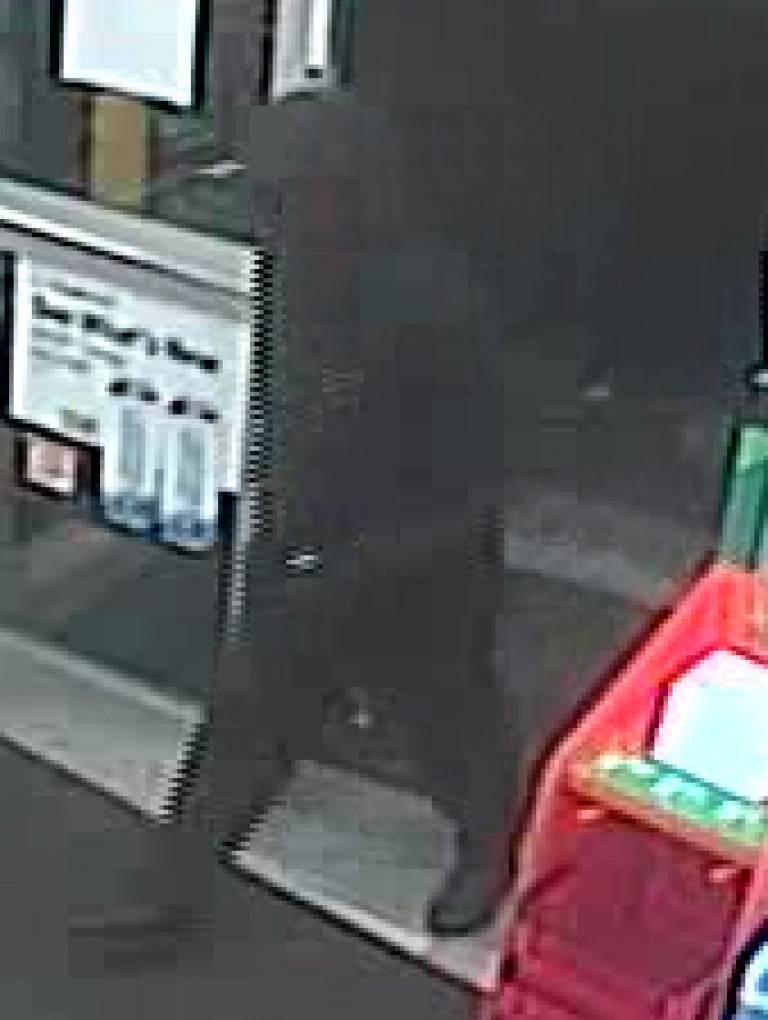
Press release:
The Batavia Police Department is investigating a robbery that occurred in the 7-Eleven convenience store on April 25 at 3:34 am.
The suspect was armed with a hammer when the robbery occurred.
The suspect was described as being a black male, approximately 5’7”, and having a slim to average build. He was also described as wearing dark-colored clothing with a maroon-colored flat-brim hat. The male is believed to have left the area on foot.
There are also photographs of two other possible witnesses (1 male and 1 female) who were in the store prior to the robbery occurring, that police are attempting to identify. The female was walking a dog, possibly a tan/brown and white colored pit-bull.
Anyone with information is asked to contact Detective Sergeant Matt Lutey at (585)345-6311, the Batavia Police Department at (585)345-6350, the Batavia Police Department's confidential tip line at (585)345-6370.
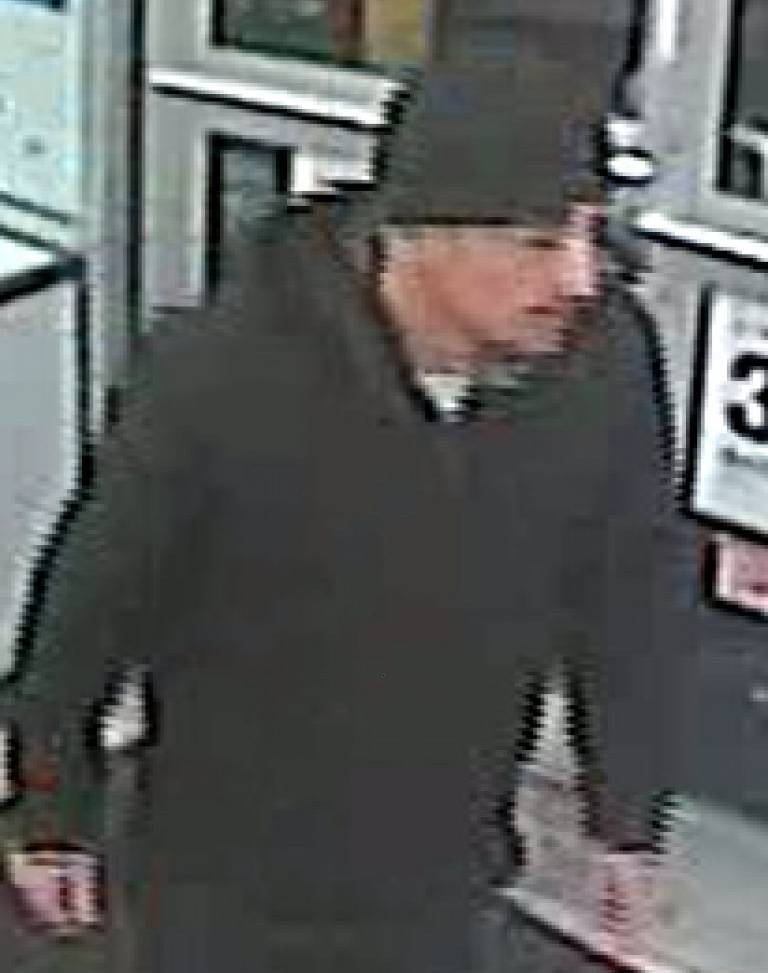


A local newspaper reported that GT&E's total assets at the year-end in 1961 were nearly $2.4 billion, which placed it at number 13 among the top corporations in the country. In addition, revenues and sales for 1961 exceeded $1.2 billion.
Sylvania Electronics merged with General Telephone to form General Telephone and Electronics (GTE) in 1959.
In 1956 and 1962, the plant was enlarged, but in 1969, a dark cloud was forming over the Sylvania plant in Batavia. There was news that a large plant was being built in Smithfield, North Carolina, and fear arose that the company might move!
In 1970, the company suffered losses from trade competition, and in October of the same year, the color television production moved to Smithfield, NC.
It was announced in 1976 that Sylvania, one of the world's largest television receiver manufacturing plants, was closing its doors. It was a sad day for Batavia's economy, especially for all the employees fortunate enough to work there.
Sylvania wasn't just a company. It was a place where friends worked together, new friends were made, and for some, they met their future wives or husbands.
Richard Oddo was one of the many employees who worked for 28 years at the plant on Ellicott St. Rd. He began working there right out of high school.
I interviewed Dick to learn about his feelings about being employed at Sylvania. He worked in the Service Department as an electronic technician. Sylvania also trained him to be on board with the ever-changing technology in the '50s right up to the plant's closing. The Employees Sales Store was a gift to this area. If a set was damaged in transit, it would be fixed in his department and then put up for sale. Some of the company's upper echelons took a new set home on trial to observe firsthand the quality of the picture of the television set. After the trial observation, the set was put into the Employee Store for sale. Dick was one of the people to see a "new" TV set.
He described his years at Sylvania as a wonderful experience. He said it was a joy to go to work every day. It was a well-organized company, clean, and everyone worked together. It had good health benefits and was very family oriented. For example, there would be a Christmas party for the employees' children and summer family picnics. Sylvania Employees Association also hosted annual dinners. In addition, Sylvania sponsored three sports teams, bowling, softball, and golf.
Sylvania always wanted to be on the cutting edge with its products. To learn about competitors, it would purchase a television set from another country or company, have its engineers tear it down, and examine the contents. One of the first TV sets to be explored was a set from Japan. After the set was examined, it was put back together and sold in the Employee Store. Dick was the fortunate one to buy that particular set. He was one of the first people in Batavia to own a color TV set. I was also the lucky one to live next door to the Oddos. When Dick was at his second job, I would go to his house and watch the marvelous small-screen invention of a color TV set with his wife and children.
In the '60s and 70s, just about every family in the area owned a Sylvania TV. They also could have owned a Sylvania transistor radio and, later on, a turntable, receiver, speakers, and a VCR. You could listen to possibly five albums simultaneously on the turntable. You could rattle the windows if you had a good set of speakers.
Another memory was the long piece of furniture that sat in your living room that contained a color television and a high-fidelity stereo system. There were many choices of designs, from Mediterranean or French Provincial to Colonial. Another early advertisement read, "23-inch console model, multi-function wireless remote control. The remote tuner turns the set on and off, changes channels, and adjusts volume using a transistorized hand control."
Over the years, the technology kept improving. After one year, a new model would appear better than the previous year. Today the iPod shuffle has taken the place of our Walkman; a DVR has taken the place of the VCR and the CDs and CD players, our albums and stereo receiver. You can't forget our cell phones that can do everything in one small device. Trying to explain to the younger set what it was like in the early years of technology is challenging.
I, for one, would not change a thing about living in the '60s. There was just something exceptional about listening to the Beatles sing "I Want to Hold Your Hand" on your high-fidelity stereo system. The one theme remains the same: people like to listen to music and watch movies and TV shows. The only thing that has changed is the size of the electric device and the cost. How lucky the people in Genesee County and surrounding areas were to have had the Sylvania plant in their backyard.
It was a sad day when Sylvanias closed its doors in Batavia for the last time and moved to another state.
Today, the word Sylvania is just a memory to those who worked there and to the many customers who knew someone who worked there.


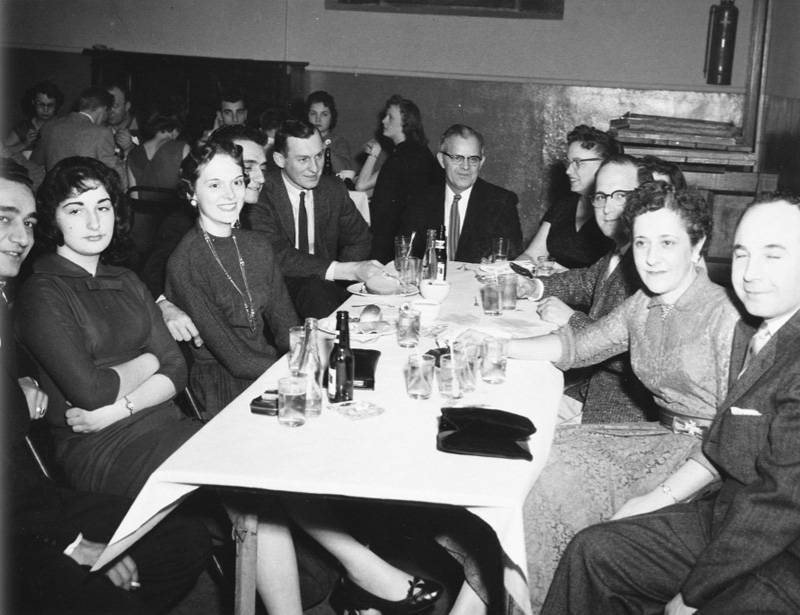

Pronipoti, meaning great-grandchildren or descendants in Italian, according to organizer Carmen DelPlato, has an important meaning for many local families with Italian heritage wanting to gather and make new connections during a special type of reunion.
Descendants from Valva, Italy -- an Italian town and municipality in the Province of Salerno in the southwestern region of Campania -- will be meeting for a second time to share stories and to make those connections from 3 to 5 p.m. May 27 at Roman’s restaurant in the downstairs lounge.
"Just to give you a little insight, many families immigrated to Batavia from Valva," DelPlato said. "In some social circles, Batavia was referred to as Little Valva!"
This group first met just before COVID in 2019, DelPlato said. Participants are asked to bring a copy of their family trees to share with others.
The cost is $10 at the door. Light appetizers will be served, and there will be a cash bar.
Roman's is located at 59 Main St., Batavia. Space will be limited, so RSVP by May 17 to BataviaValva2023@gmail.com


Submitted photos of the inaugural get-together of Valva, Italy descendants.

Press Release:
The 23rd Annual Batavia Rotary Club High School Tournament will take place Saturday, May 5th, at Dwyer Stadium.
Attica will play Batavia in the first game at 11 a.m., followed by Oakfield-Alabama vs. Notre Dame at 2 p.m.
The winners of those two contests will play in the championship game under the lights starting at 7 p.m.
Admission is $5 for an adult all-day pass and $3 for a student or senior all-day pass. All proceeds from the tournament will help benefit Batavia Rotary Club charities.
Photo: File photo by Howard Owens

Somewhat unexpectedly, Batavia Sports Park, operated by Batavia Turf in the town of Batavia, is hosting the Metro East Regional Championships for Ultimate Frisbee Football.
The tournament, which features teams from colleges and universities from throughout the region, was originally slated for fields in New Jersey, but the owner of that facility decided at pretty much the last minute they really didn't have enough space to host the event.
Jack Richards, president of the RIT team and tournament director, was able to move the event to Batavia.
Ultimate Frisbee Football is a 7-on-7 competition that involves flinging a frisbee downfield in an attempt to score a goal. Players cannot run with the Frisbee. When a player catches the disk, the player must stop running and find a teammate to toss it to. The player is being guarded by a defender, and the player's teammates are guarded (defenses, like basketball, can be man-on-man or zone). Defenders can knock down a flung Frisbee, which leads to a change of position at the position in the field where the Frisbee falls.
The top men's team and the top women's team from this weekend's tournament will advance to the national finals.
Ultimate Frisbee Football is now recognized by the International Olympic Committee and will be part of the 2028 Olympics.
Photos by Howard Owens








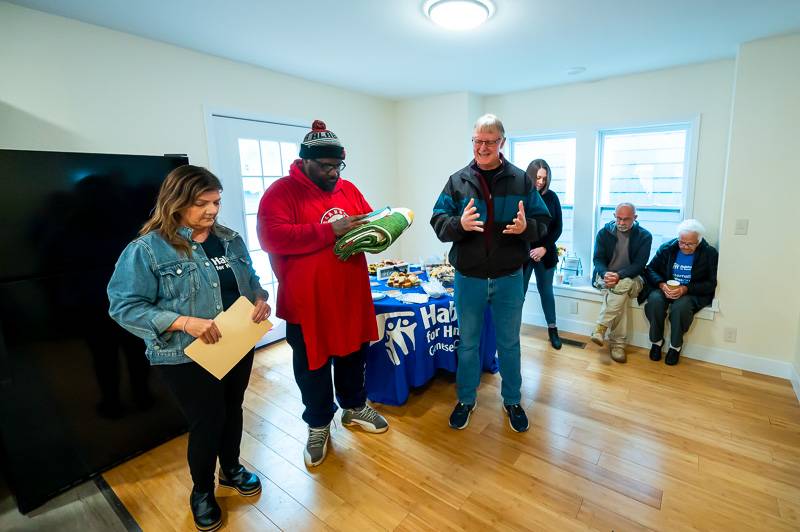
It was no accident that brought together a group of caring people at 50 Oak St., Batavia, on Saturday, said Pastor Vern Saile before blessing the new home of Terry Smith and his family.
"What strikes me is how many people came together to make this possible for you," Saile said. "I believe that God brought those people together for you. You know, the Bible says, 'Unless the Lord builds the house, its builders labor in vain.' I have no doubt that the Lord has built this house for you, Terry. And it's his love that started this project. It is his love that carried it through, and it is his love that will carry it forward."
Smith started the home acquisition process with Genesee County Habitat for Humanity nearly five years ago. It meant a lot to him, he said, to provide a home for his children, one they can count on as permanent for the rest of their childhoods.
The house was a tax-lien foreclosure by the City of Batavia that the city transferred to Habitat rather than put it up for auction.
"The ability of the City of Batavia to encourage rehabilitation of houses and promotion of single-family home ownership is enhanced by the strategy to move foreclosed properties into a program like Habitat for Humanity," said City Manager Rachael J. Tabelski. "The restoration of homes, and the ability to match families, who are ready to make the move to home ownership, and adds exponential value to neighborhoods, as opposed to auctioning the property into the rental market.”
Jaylene Smith-Kilner, executive director of Habitat, thanked a long list of people who made this home, Habitat's 26th build, possible, from government officials and agencies to small business owners and local volunteers and donors.
Smith said that effort that help was a blessing and that he is excited for his kids.
He's watched Habitat, along with his own labor as part of the process, transform an old house into a beautiful home.
"Seeing the process from it being completely gutted to how it is now, it's just so crazy process," Smith said. "It's a crazy process, and they did a good job. I got mad love for all the Habitat family community."
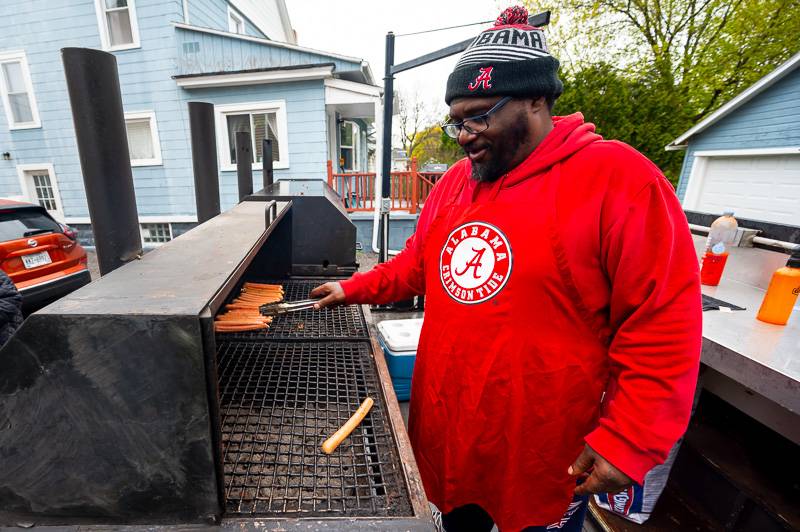

Marianne Newmark, with USDA Rural Development, discussed how her agency assists potential Habitat for Humanity homeowners get the financing necessary to close on their house.
They help the homeowner secure low-interest, longer-term loans so they have affordable house payments.
"We love partnering with Habitat for that, and that Habitat takes these houses and makes them beautiful, and really renovates them to the point where the homeowners don't have to worry about, 'Oh no, I just bought this house, and I have to do so much work on top of my new mortgage payment,'" Newmark said. "They take a lot of that stress out of the way in the beginning."
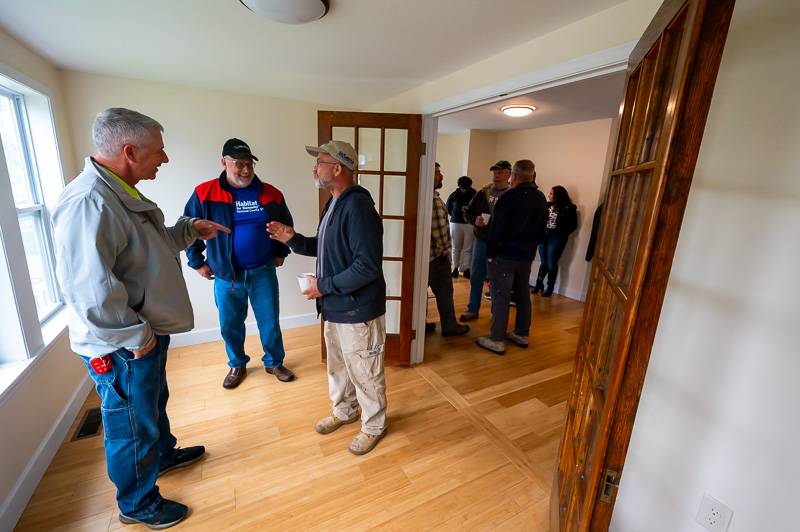




If you’ve ever had health or safety concerns about certain aspects of your household, but didn’t know who to call, don’t worry: help is coming your way with the Healthy Neighborhoods Program. And there might even be some free goodies thrown in for participating.
That is, if you live in Wards Two or Five in the City of Batavia. Genesee County Health Department staff will be going door-to-door based on census tracts, and this year it’s those two wards, environmental health professional Karen Schmidt said during a recent presentation to City Council.
“The Healthy Neighborhoods program is a grant from the New York State Department of Health. It's a five-year grant and runs from 2020 to 2027. So we just started our second year … health department staff make home visits to people. It's for renters and homeowners, it doesn't matter. And our target area right now is the town and the city of Batavia. Our goal is 200 visits per year,” Schmidt said.
Staff goes door-to-door to survey certain potential health issues, such as smoking and asthma. If anyone in the home smokes or has asthma, “we have more information for those people,” she said. But it’s not all about one’s direct personal health, she said.
“We check for fire safety in the home, for working smoke detectors, windows and doors that are accessible in an emergency, that there’s not a lot of clutter that would prevent you from being able to leave,” she said. “We check for lead hazards in homes that were built before 1978 because that is the year that they banned lead from consumer paint. So for that, we look for deteriorated paint because it’s the dust or the particles that are the hazard.”
Mind you, this doesn’t take off from the initial visit from a stranger at the door. They typically leave a hanger packet of information and set up an appointment if the homeowner is interested in this health and safety review. It also includes indoor air quality, checking to see if anyone smokes inside, and if so, encouraging them to take it outside.
“And then just the general condition of the house, are there major roof leaks, plumbing leaks, are the floors, the stairs, the railings in good condition,” she said. “And we have a referral sheet that’s to agencies or providers of services that might be applicable. We don’t have the budget to do repairs ourselves, or we can try to refer them to community groups to help, and then we have the free supplies (top photo of smoke detector, fire extinguisher, radon test kit, first aid kit, cleaning supplies).”
For those with asthma, staff helps to educate them about potential triggers, the importance of talking to their doctor, when to take their meds, and what to take in an emergency to avoid a trip to the emergency room. Senior citizens may be referred to Office for the Aging to receive assistance for their particular needs, such as handrails or advice for family issues. Staff also can point people to food pantries, the community closet and other resources, she said.
The Batavian asked follow-up questions, and Schmidt and Public Information Officer Kaitlin Pettine gave the following responses.
Does staff give demonstrations of how to use wellness equipment?
“If possible, we want the equipment installed before we leave. We are working with the City of Batavia Fire Department to install smoke detectors going forward. We also make sure that carbon monoxide detectors are activated and discuss the proper placement. For fire extinguishers, we provide a brochure on usage and give brief instructions,” they said.
Why would they want to take a few minutes to listen?
“Most people could use a quick check of hazards to look for in their homes. It is better to be aware and plan for an emergency, than to be caught off guard.”
What time period are you going out in Batavia?
"We do not have a set schedule for when we go out, and the time changes each week based on the weather, staff availability, etc. However, we try to go into the community several hours a week. We try to alternate between areas and time of day. As the weather gets better and we get into late spring and summer, we hope to spend more time going door-to-door. We also plan to attend community events to spread awareness about the program."
Will you be moving into other areas after the city? If so, where?
"This year, we are going door to door in census tracts 9507 (Ward 5) and 9508 (Ward 2) in the City of Batavia. However, any resident of the City or Town of Batavia is eligible for the program and we accept referrals at any time."
Will you be distinguishable, so that people will know it's you and not a salesperson?
"When we go door-to-door, staff wear Genesee County Health Department badges and identify themselves as health department employees when someone opens the door,” they said. “If someone is hesitant, we encourage them to go to GOHealthNY.org to get some more information. There they can fill out a referral form online if they are interested in the program. Staff will then schedule an appointment that is at a convenient time for the resident.”
What's the overall message that you hope to convey to families?
"The Healthy Neighborhoods Program can make a difference by reducing housing related illness and injury through home inspections and prevention. Staff will identify problems that exist and refer residents to local agencies or programs when it is appropriate."
The Genesee County Health Department received $477,000 in funding from the New York State Department of Health (NYSDOH) to implement the Healthy Neighborhoods Program (HNP) for the years 2022 to 2027.
For more information or to make a referral to the program, call Genesee County HNP staff at 585-344-2580, Ext. 5519, or visit www.GOHealthNY.org.
Photo of free items given during home visits from GO HealthNY.
A motor vehicle accident with injuries and blocking is reported in the area of 4063 West Main Street Road, Batavia.
Town of Batavia Fire, along with Mercy EMS dispatched.
UPDATE 10:11 a.m.: A first responder reports that the road is not blocked. Both vehicles have pulled into a business's parking lot.
UPDATE 10:12 a.m.: Two patients, one ambulance sufficient, hold the assignment to Rescue 20.
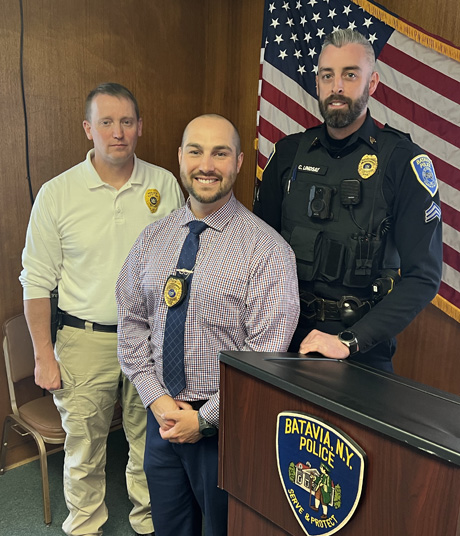
Ask the people -- police officers -- who deal every day with crime victims, and those accused of committing the crimes, and New York's landmark 2019 bail reform law just isn't working.
It isn't working for victims, because they either get re-victimized, or there are new people victimized because accused criminals are free sooner to commit new crimes, or victims simply decline to press charges because they know the accused person will just be issued an appearance ticket.
And it has also failed the people it was supposedly designed to help: criminal defendants.
Those accused of a crime are now more frequently set free to commit new crimes and dig themselves into a deeper hole, or they don't appear before a judge or go to jail where they are afforded the opportunity they need to enter substance abuse programs.
"The joke is (among officers), it's like fishing. It's 'catch and release,'" said Batavia PD Det. James Defreze.
Chief Shawn Heubusch added, "It is catch and release, and they understand, the officers understand, what the laws are, and we're here to enforce the laws. But the laws are not helping our citizens. At least this particular law is not helping our citizens. It's not helping the community at large."
The Batavian spoke with Heubusch, Defreze, and Sgt. Christopher "CJ" Lindsay this week about the impact of bail reform on the department and the community after a series of press releases from Batavia PD about individuals who have been arrested multiple times on warrants for failure to appear for various minor offenses.
In press releases about arrests, Batavia PD has recently been highlighting criminal defendants who get are repeatedly arrested on failure-to-appear warrants three, four, or five times. Unfortunately, there isn't clear data that judges are issuing, in the aggregate, more warrants, because, by policy, the department no longer seeks warrants on unpaid parking tickets, and with the legalization of cannabis possession, there are fewer marijuana-related arrests. That means there is no way to make a meaningful comparison from one year to the next of the total number of warrants.
The Why of Bail Reform
The path to bail reform in New York perhaps began in 2015 with the death of Kalief Browder. Browder had been held in Rikers Island on cash bail of $3,000 after being accused of stealing a backpack. Browder said he was subjected to mental and physical abuse. His charges were dropped after three years of pre-trial condiment for lack of evidence. Upon his release, he committed suicide.
Advocates for bail reform said confining poor people, who can rarely make bail, on charges without conviction was a violation, at least in spirit, of due process. Advocates pointed to statistics that poor blacks, especially in the state's cities, were more likely to be held on bail, than white defendants.
In 2018, in his State of the State speech, Gov. Andrew Cuomo picked up the cause of bail reform.
"Let's be painfully honest: The truth is that our Lady Justice is still not colorblind, and her scales are still not balanced," Cuomo said. "Our bail system is biased against the poor. Too many jails are cruel and inhumane, and our court system is too slow."
Bail reform was approved by the State Legislature in 2019 and was meant to reduce incarceration by limiting the need for defendants to come up with money to pay for their liberty. The new law mandated pretrial release for the majority of nonviolent charges and required that judges consider a person’s ability to come up with the cash to pay bail or security to post bond.
On low-level, non-violent charges, officers must issue appearance tickets rather than hold the suspect for arraignment (where, in most cases, they would have been released under the old system). When suspects are arraigned, judges must release defendants without requiring bail and with no conditions on their release ("on their own recognizance"). In certain conditions, they can put conditions on their release ("released under supervision"). If bail can be set, the bail amount must be the lowest amount possible that is affordable for the defendant. That's why you sometimes see bail set at $1.
There are multiple exceptions and conditions that police officers and judges must follow. That is one of the complaints lodged by Heubusch. The bail system is arcane and confusing.
As an example, Heubusch cited a recent case where a suspect was arrested for burglarizing a restaurant. The suspect was released following his arrest. The next day, he burglarized another restaurant. The judge misunderstood the standards of the bail reform law in this particular circumstance and released the suspect again. He was arrested 20 minutes later after burglarizing another restaurant.
"So we now have one individual that has three burglary charges -- felony burglary charges," Heubusch said. "Again, he could have been held on that second arraignment, but there was a misunderstanding between the judges as to what they can actually do when it comes to that type of thing."
To help us understand how complex the new bail rules are, Heubusch pointed us to this web page on bail reform for the state's public defenders. It contains this matrix of qualifying (for bail) and non-qualifying (no bail) options. It also contains this flow chart that helps guide anybody in the justice system on when to require bail or when to release a defendant.
Bail reform makes law enforcement harder
Being a police officer is inherently a risky job, and police officers accept that risk, Heubusch said. It's also a tough job where officers are expected to deal sometimes with uncooperative or even hostile criminal suspects. But that aspect of the job has been made worse, by bail reform, Heubusch said.
He said when people understand they're going to get an appearance ticket, they're more likely to flee or or fight with an officer because resisting arrest won't elevate the seriousness of their criminal activity.
"We've seen people run from us, fight with us, and attack us more than they did before, in my opinion, because they know, it's not taken as seriously or, you know, 'haha, I can get away with it. I'm gonna get a slap on the wrist from the judge. See you next week or see you tomorrow,' that type of thing," Heubusch said. "It just seems that the attitude, to resist arrest, to fight with the cops, has increased."
Bail reform has also made it hard to get drug dealers off the street, Defreze said.
First, the Class B felony of criminal sale of a controlled substance in the third degree is a non-qualifying offense, meaning a judge can't automatically set bail. Defreze said he's seen dealers back on the street selling narcotics within five hours of their arrest.
"Pre-Bail Reform, we were pretty effective and successful in removing drug dealers from our community," Defreze said. "We would find people, we would arrest them for possession with intent to sell or for criminal sale, both (Class) B felonies. When we got the indictment warrants, those people would go to jail. Now the majority of these people are getting charged with two to four Class B felonies, and they go see a judge, and they're released. Then people were calling, saying these people are selling drugs in my neighborhood."
That arrest was made after months of work that involved finding and working with a confidential informant, gathering evidence, reviewing the evidence with the district attorney, and presenting the evidence to a judge to get a warrant either for a search or an arrest.
When a recently released dealer just hits the street again, he can't just be arrested on the spot. The whole process must start again.
But now it's harder to find confidential informants.
"Bail Reform, in and of itself, made getting a CI inherently harder," Defreze said. "People used to be, there was some kind of fear that they were going to go to jail for minor offenses. You'd catch someone for stealing from Tops, and they wouldn't want to go to jail for that. They would cooperate to have that charge go away. I mean, CIs for minor offenses are a thing of the past."
Victims
Bail reform hasn't been good for crime victims, the officers said.
"What's been missed during this whole thing, just from my perspective, is we've completely forgotten about the victims," Heubusch said. "We've created a system that cares about the defendants, and we care about the defendants as well, we certainly want don't want to hold somebody for years upon years upon years on petty crimes because that doesn't make any sense. But the victims are now being re-victimized over and over again by the same offenders. So I think that's, that's the biggest frustration that you see from law enforcement because we are out there trying to make sure that our communities are safe."
In March, deputies arrested two men in Elba on property crimes. Under terms of Bail Reform, the deputies had no choice but to release the suspects on appearance tickets. The two men were processed at the Genesee County Jail and released. Upon their release, they allegedly stole a car, leading to a police pursuit across multiple jurisdictions.
Bail reform has made orders of protection less effective, the officers said.
Domestic abuse always involves a human victim, so that means the arresting officer can haul the suspect in front of a judge for an arraignment. That gives a judge a chance to issue an order of protection, but unless the crime is a qualifying violent felony, the judge has -- at least until now -- limited power to set bail.
"I can think of a domestic situation where somebody was arrested for harassment, and they were arraigned in front of the judge, got an order of protection, but they had to be released, and they went right back to the house and violated the order protection," Heubusch said.
Bail reform has also led crime victims to ask officers not to arrest offenders, Lindsay said.
"Obviously, we understand the defendants have rights but like (Heubusch) said, we kind of forget about the victims," Lindsay said. "I've had numerous times where we have a case where the victim wants to have someone arrested, so they'll ask us, 'are they going to be held in jail,' and we tell them, 'no, we can't hold them, so they say 'well, I don't want him arrested then because I don't want to deal with whatever fallout.'"
Lindsay said victims are also frustrated.
"We're probably dealing with more angry victims," Lindsay said.
The law is confusing
Heubusch came to the interview with The Batavian carrying a sheaf of paper. He had printed out the matrix, flow charts, and rules officers, attorneys, and judges must know in order to ensure nobody is jailed in violation of the law.
It's a lot to know and a lot to keep up with, and even sometimes judges get it wrong, he said.
"We had a situation where an individual burglarized a restaurant," Heubusch said. "He was arraigned, released and burglarized another business that weekend. He was arraigned, and the judge misunderstood that it was a new charge and released him. He burglarized another restaurant after he left. So we now have one individual that has three burglary charges -- felony burglary charges. And, again, could have been held on that second arraignment, but there's a misunderstanding between the judges as to what they can actually do when it comes to that type of thing."
Defendants harmed by Bail Reform
When defendants are released on appearance tickets, no judge gets an opportunity to recommend a substance abuse or mental health program. When a criminal defendant is free to re-offend, they sometimes do.
"If you look at it, from the defendants' standpoint, this person now has the opportunity to rack up multiple criminal charges to make that sentence, maybe harsher on them," Heubusch said.
He said his officers have seen defense attorneys ask judges to set bail in cases for the sake of their defendants.
"The only way they know their guy is gonna get help is by sitting in jail because the jail will provide that assistance to them, whether they want it or not," Heubusch said. "It'll at least be in front of them. If they get to walk away from that arraignment without being held, the chances of them going out and reoffending are very good. The chances of them going on or overdosing and dying are even higher."
We asked Heubusch in a follow-up email if he had any data on the number of times defendants have been released from custody only to OD, and Heubusch said, "I am not able to put together stats as quickly as I would like to, but we do have cases where individuals that we know to have substance abuse issues have committed crimes and while out pre-trial they have overdosed and died. If judges had the ability to incarcerate these individuals for, what the lawmakers are calling petty crimes, they would be offered assistance and/or mandated assistance pre-trial. This could keep some alive."
Ideas to reform the reform
The police chiefs in New York, Heubusch said, have their own ideas about how to fix bail reform.
First, end cash bail. That is, in fact, right in line with what downstate reformers want. Defendants should either be held pre-trail, with no bail, or released. That would end the perceived unfairness of people with a bit of money being able to get released while poor defendants must stay locked up, unable to get to jobs or care for families.
"The amount of money sitting in your bank account should not determine if you're a free person or not," Heubusch said.
And allow judges to determine whether a person is a danger to himself, another person, or the community.
"We're the only state in the United States that doesn't have a dangerous statute in our law," Heubusch said. "Bail is set specifically upon reappearance for court. We're the only one that doesn't include dangerousness. I don't know why New York wants to lead the way in that, quite honestly, because the communities are suffering because of it. So eliminate cash bail altogether. There's no reason to have a $1 value on it. You're either held to your release, or you're released upon certain restrictions and then that can be reviewed at your next appearance."
Some reformers consider "dangerousness" too subjective of a standard. Heubusch countered that trying to determine if somebody is a flight risk is a judgment call.
Reformers are concerned that allowing judges discretion raises the specter of bias, and studies show the criminal justice system has a history of being biased against people of color. Heubusch said race should absolutely not be a factor in who is held and who is released but blanket policies by lawmakers who don't live in the communities dealing with crime are not the solution to racism.
"If judges are using race to incarcerate people, then they should be held accountable," Heubusch said. "We should not be changing the system so that more people can be victimized. We are allowing people who commit crimes to remain free due to decisions by lawmakers who are not dealing with these individuals in our communities."
The officers know the current bail scheme is not helping local communities, they said, because they see it every day.
"You really have to explain to the folks that are there complaining about what's going on in their neighborhood, that we can only go so far," Heubusch said. "The reason this person is not locked up is not because of me. It's not because of the judge. It's because of the state laws that say they can't be locked up. It's because of the state laws that say they can't be evicted from that apartment. It's because of the state law. You know, it's very difficult to explain that to somebody who really just wants to see their neighborhood get better."
Photo by Howard Owens. Chief Shawn Heubusch, Det. James Defreze, and Sgt. Christopher Lindsay
After a brief discussion Monday evening, City Council agreed to forward a residency waiver to its next business meeting for a vote.
The residency requirement for Fire Chief Josh Graham was to be in effect within six months of his hiring, which is up this month. Apparently, Graham requested an extension of that waiver, and most of council seemed to be in agreement to grant it.
Councilman Bob Bialkowski was the only one to question whether the chief used a city vehicle to drive to his home in Wyoming County, and Council President Eugene Jankowski Jr. said yes, as is the case for department heads.
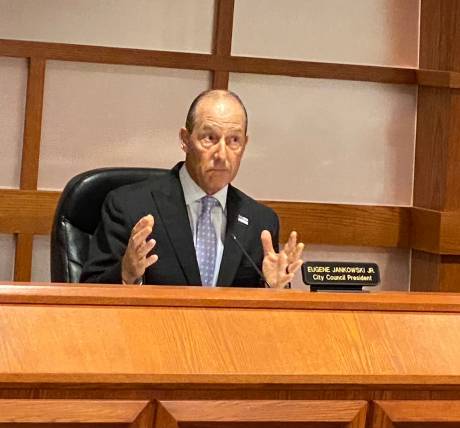
When asked by The Batavian why the city was granting a waiver extension, Jankowski said that it was temporary.
“Until the situation changes. I can’t discuss the reasoning as to why,” he said. “I have no concerns, and if you come to work on time and you’re on-call and you’re here in a reasonable amount of time, I don’t have a problem with that.”
Council had at one time discussed widening the circle of territory for where city department heads could live and maintain residency requirements, Jankowski said. Other city officials have been granted such extensions of living outside of the city, including former and current police chiefs and assistant city managers, including the most recent one, Erik Fix, who lives in Le Roy.
Jankowski said he felt that as long as people made it to work on time and didn’t mind a longer commute and dealing with bad weather, it was ok with him.
But others disagreed, so they now take such situations on a case-by-case basis, he said.
By no means will there be a carte blanche residency waiver system, he said. This is just one of those individual cases, and council wants to work with a valuable employee, he said.
“He’s doing a great job,” Jankowski said of the fire chief.
File photo of Eugene Jankowski Jr. by Joanne Beck.

Click here for more information on 9099 Creek Road, Batavia.
Click here for more information on 7 Gateway Drive, Batavia.

Derek Geib, entrepreneur, property owner and president of the Business Improvement District, has been a tight-lipped businessman.
He didn’t have much to say when voted in as president of the BID while operating successful enterprises with Bourbon & Burger, The Coffee Press and Roman’s, all in downtown Batavia.
Now it appears as though Geib has more ventures on his to-do list, with a proposal to buy parcels 11A and 11B in the City Centre from the city of Batavia.
When reached Monday, Geib would not go on record with any comments about the purchase or his plans for the mall property. He wouldn’t even give a hint about what type of business might be going into the space formerly occupied by Valle Jewelers several years ago.
City management had previously requested permission from City Council for a reassessment of vacant properties, and 11A and B were evaluated to be worth $60,000 as fair market value by Lynne, Murphy & Associates, Inc.
Geib, operating under Geib Estates Corp., agreed to pay the price tag, plus additional expenses. Assistant City Manager Erik Fix recommended that the city “continue to foster development and activity in the Batavia City Centre, a unique downtown asset, and authorize this sale.”
“The property will go onto the tax rolls, and all the appraisal fees and closing costs will be paid by Geib Estates Corp.,” Fix said during City Council’s conference session Monday evening.
The purchase would align with the city’s Downtown Revitalization Initiative, Brownfield Opportunity Area and Strategic plans, Fix said in his memo to City Manager Rachael Tabelski.
Councilman Bob Bialkowski asked about the property’s assessed value and when the sale would actually take place. City Attorney George Van Nest said that a survey and title search will have to be completed first, which “can take a little bit of time.”
“But once that is done, we’ll make arrangements to have a closing and transfer the title,” he said.
Tabelski estimated that it would probably be in the summer, possibly in July. No one had an answer about the assessed value. According to online assessment records, the 2022 full market value is $124,000. For years, it has been sitting unoccupied.
“Yes, put it back to work, I’m in favor of this,” Bialkowski said.
A resolution will be on the next business meeting agenda for council’s vote.
Photo of former Valle Jewelers property in Batavia City Centre from online assessment website.
Copyright © 2008-2022 The Batavian. All Rights Reserved. Privacy Policy | Terms of Service